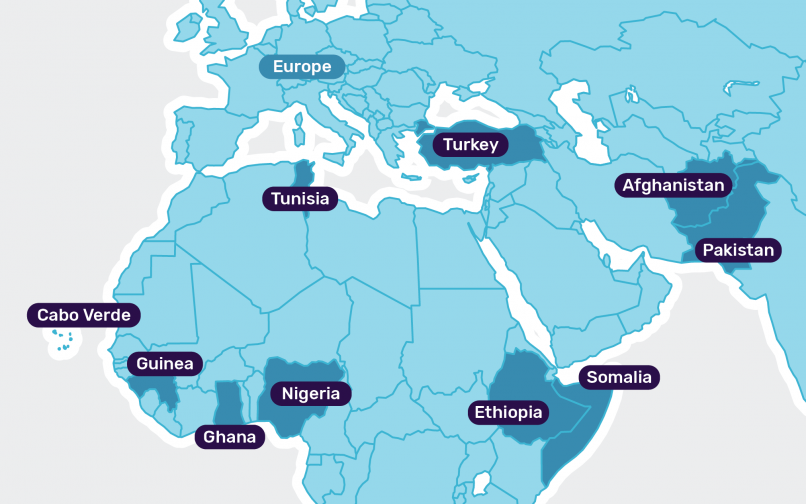Countries
We conduct research across ten countries on the causes and consequences of migration. These are all countries of origin or transit for migration to Europe, and span diverse migration and development contexts.
Jump to: Afghanistan, Cabo Verde, Ethiopia, Ghana, Guinea, Nigeria, Pakistan, Somalia, Tunisia, Turkey
Within each of the ten countries, we do a policy review that focuses on national-level policy related to migration and development. Research in each country will focus on two or three areas, to be selected in the second half of 2019. In this way, we document how connections between migration, development and policy play out in diverse localities.
MIGNEX is not confined to the ten countries where the research areas are located. Some of our research is focused on Europe, examining migration and development policy and how it is implemented. Moreover, we address the conceptual and methodological aspects of migration and development that are relevant at the global level.
Afghanistan
Afghanistan is a landlocked country located in South and Central Asia, with a population of 30 million. Four decades of conflict, insecurity and extreme poverty have led to large-scale forced displacement in and from Afghanistan. There are three million Afghan refugees in neighbouring Pakistan and Iran, and large numbers irregularly migrate to Europe every year, peaking at an estimated 250,000 in 2015.
Cabo Verde
Cabo Verde is an island nation off the coast of West Africa with a population of just over half a million, spread across nine islands. Migration has been a pivotal feature of the society and economy for centuries. Around the turn of the Millennium, income from international tourism surpassed remittances as the main source of foreign exchange. Levels of income, education and life expectancy are among the highest in Africa. In English, the country is also known unofficially as Cape Verde.
Ethiopia
Ethiopia is the largest landlocked country in the world, with a population of over 100 million. Until the 1990s, it was the largest migrant-sending country in Africa, with high numbers fleeing conflict and widespread famine and poverty. Now relatively stable, it has become a key destination for migrants and is one of Africa’s largest refugee-hosting countries. It is also an important transit route. Thousands of Ethiopians migrate every year to the Gulf and South Africa.
Ghana
Ghana in West Africa has a population of around 30 million. During the 1970s, a declining economy led to large-scale emigration, predominantly to neighbouring countries, and later to Europe and North America. Today, the country has one of the fastest-growing economies in sub-Saharan Africa, and is politically stable. Yet aspirations to migrate remain prevalent. Migration has continued, mainly to other countries in the region, although thousands irregularly migrate to Europe each year.
Guinea
Guinea is situated in West Africa with a population of 12 million. Whilst the country is rich in mineral resources, Guineans are among some of the poorest in West Africa. Political instability is high and the country was at the centre of the deadly outbreak of the Ebola virus in 2014, killing over 11,000 in two years. Guineans are one of the most represented nationalities irregularly migrating to Europe.
Nigeria
Nigeria is the most populous country in Africa with more than 200 million inhabitants. Historically, Nigeria is both a key country of destination for migrating West Africans, and a country of origin. Political tensions and economic stagnation in the 1970s stimulated substantial migration to Europe, the United States and the Gulf. Armed conflict in several parts of Nigeria has led to large-scale displacement within and beyond the country’s borders. Migration dynamics differ greatly across Nigeria.
Pakistan
Pakistan is the fifth most populous country in the world, with over 210 million people. In recent decades Pakistan has been a key country of emigration, primarily to the Gulf. There is also a notable diaspora population of 1.5 million in the UK. Large numbers of refugees and other migrants from South Asia – in particular, Bangladeshis and Afghans – reside in Pakistan, often, but not always, en route to the Middle East and Europe.
Somalia
Somalia is located in the Horn of Africa with a population of around 14 million inhabitants. Somalia is one of the most fragile states in the world. For decades extreme political instability, widespread drought and violent clan wars have repeatedly displaced 100,000s of Somalis, predominantly to neighbouring Ethiopia and Kenya. High numbers of young Somalis migrate through irregular means to Europe.
Tunisia
Tunisia has a population of 11 million and is situated in North Africa. Bordering the Mediterranean, it has traditionally been a country of emigration, and there is a sizeable Tunisian diaspora in France and Italy. The Arab Spring in 2011 increased political tensions and social and economic instability, including soaring unemployment, driving large numbers of mostly young Tunisians to migrate to Europe, often through irregular means. Tunisia is home to thousands of migrants from sub-Saharan Africa, many on their way to the Mediterranean and Europe.
Turkey
Turkey, a country of 82 million people bordering the EU and the Middle East, has historically been a source of emigration – particularly labour migration to the then West Germany – but is now categorized as a country of net immigration. Turkey has for decades hosted large numbers of refugees, including more recently millions of Syrians. Large numbers of irregular migrants and asylum-seekers transit through Turkey, as a route to Europe, particularly from Afghanistan, Iran, Iraq, Pakistan and Syria.
